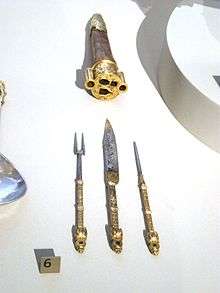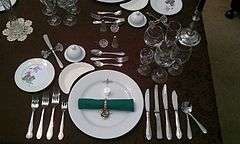Cutlery

Cutlery includes any hand implement used in preparing, serving, and especially eating food in Western culture. A person who makes or sells cutlery is called a cutler. The city of Sheffield in England has been famous for the production of cutlery since the 17th century and a train – the Master Cutler – running from Sheffield to London was named after the industry.[1]
Cutlery is more usually known as silverware or flatware in the United States, where cutlery usually means knives and related cutting instruments. Although the term silverware is used irrespective of the material composition of the utensils, the term tableware has come into use to avoid the implication that they are made of silver.
The major items of cutlery in Western culture are the knife, fork and spoon. In recent times, hybrid versions of cutlery have been made combining the functionality of different eating implements, including the spork (spoon / fork), spife (spoon / knife), and knork (knife / fork) or the sporf which combines all three.
Etymology
The word cutler derives from the Middle English word 'cuteler' and this in turn derives from Old French 'coutelier' which comes from 'coutel'; meaning knife (modern French: couteau).[2] The word's early origins can be seen in the Latin word 'culter' (knife).
The first documented use of the term "cutler" in Sheffield appeared in a 1297 tax return. A Sheffield knife was listed in the King's possession in the Tower of London fifty years later. Several knives dating from the 14th century are on display at the Cutlers' Hall in Sheffield.[2]
Composition

Sterling silver is the traditional material from which good quality cutlery is made (hence the usage of the term in the United States). Historically, silver had the advantage over other metals of being less chemically reactive. Chemical reactions between certain foods and the cutlery metal can lead to unpleasant tastes. Gold is even less reactive than silver, but the use of gold cutlery was confined to the exceptionally wealthy, such as monarchs.[3]
Even comparatively modest households might have one or two items of silver, often silver spoons. Wealthy individuals would own large sets containing a range of specialised dining implements, such as the comprehensive set in sterling silver made for the French aristocrat Marie-Joseph Paul Yves Roch Gilbert du Motier (known as the Marquis de Lafayette) by the Towle Manufacturing Company. It contained, among many other items, a gravy ladle, mustard spoon and lettuce fork.[4]
Steel was always used for more utilitarian knives, and pewter was used for some cheaper items, especially spoons. From the nineteenth century, electroplated nickel silver (EPNS) was used as a cheaper substitute for sterling silver.
In 1913, the British metallurgist Harry Brearley discovered stainless steel by chance and this metal has come to be the predominant one used in cutlery. An alternative is melchior, corrosion-resistant nickel and copper alloy, which can also sometimes contain manganese and nickel-iron.
Plastic cutlery is made for disposable use, and is frequently used outdoors for camping, excursions, and barbecues for instance. Plastic cutlery is also commonly used at fast-food or take-away outlets and provided with airline meals in economy class. Plastic is also used for children's cutlery. It is often thicker and more durable than disposable plastic cutlery. Wooden disposable cutlery is also available as a biodegradable alternative.
Industry

Cutlery has been made in many places. In Britain, the industry became concentrated by the late 16th century in and around Birmingham and Sheffield. However, the Birmingham industry increasingly concentrated on swords, made by "long cutlers", and on other edged tools, whereas the Sheffield industry concentrated on knives.
At Sheffield the trade of cutler became divided, with allied trades such as razormaker, awlbladesmith, shearsmith and forkmaker emerging and becoming distinct trades by the 18th century.
Before the mid 19th century when cheap mild steel became available due to new methods of steelmaking, knives (and other edged tools) were made by welding a strip of steel on to the piece of iron that was to be formed into a knife, or sandwiching a strip of steel between two pieces of iron. This was done because steel was then a much more expensive commodity than iron. Modern blades are sometimes laminated, but for a different reason. Since the hardest steel is brittle, a layer of hard steel may be laid between two layers of a milder, less brittle steel, for a blade that keeps a sharp edge well, and is less likely to break in service.
After fabrication, the knife had to be sharpened, originally on a grindstone, but from the late medieval period in a blade mill or (as they were known in the Sheffield region) a cutlers wheel.
Disposable cutlery

Introduced for convenience purposes (lightweight, no cleanup after the meal required), disposable cutlery made of plastic has become a huge worldwide market. Along with other disposable tableware (paper plates, plastic table covers, disposable cups, paper napkins, etc.), these products have become essential for the fast food and catering industry. The products are emblematic of throw-away societies and the cause of millions of tons of non-biodegradable plastic waste.[5]
Manufacturing centres
Traditional centres of cutlery-making include:
See also
References
- ↑ British Pathé. "The Master Cutler". britishpathe.com.
- 1 2 The Sheffield Knife Book, Geoffrey Tweedale, The Hallamshire press, 1996, ISBN 1-874718-11-3
- ↑ Miodownik, Mark (29 April 2015). "Stainless steel revolutionised eating after centuries of a bad taste in the mouth". The Guardian.
- ↑ An account of the life of Marie Joseph Paul Yves Roch Gilbert Dumotier, marquis de La Fayette ..: with illustrations of the La Fayette pattern of sterling silver tableware. Newburyport, Mass: Towle Mfg. Company. 1907. p. 67. hdl:2027/nyp.33433082423595.
- ↑ Schnurr, Riley E.J.; Alboiu, Vanessa; Chaudhary, Meenakshi; Corbett, Roan A.; Quanz, Meaghan E.; Sankar, Karthikeshwar; Srain, Harveer S.; Thavarajah, Venukasan; Xanthos, Dirk; Walker, Tony R. (2018). "Reducing marine pollution from single-use plastics (SUPs): A review". Marine Pollution Bulletin. 137: 157–171. doi:10.1016/j.marpolbul.2018.10.001.
Further reading
- Hey, D. The Fiery Blades of Hallamshire: Sheffield and Its Neighbourhood, 1660–1740 (Leicester University Press 1991). 193–140.
- Lloyd, G. I. H. The Cutlery Trades: An Historical Essay in the Economics of Small Scale Production. (1913; repr. 1968).
External links
| Look up cutlery in Wiktionary, the free dictionary. |
| Wikimedia Commons has media related to Cutlery. |
- Associazione culturale Coltellinai Forgiatori Bergamaschi - Research laboratory on damascus steel